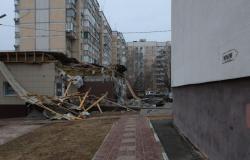Hohlraum, fuel target and progress of NIF experiments N210808 and N221204. Credit LLNL.
NIF
The NIF laser facility in California, USA, is the largest facility in the world that conducts research into nuclear fusion with inertial fuel retention. The device has 192 lasers with a total power of up to 500 TW, which can deliver more than 2 MJ of energy to the fuel target. In 2021, a significant success was achieved at the facility when experiment N210808 managed to release 1.3 MJ of fusion energy. A year later, in December 2022, a record-breaking experiment followed N221204, during which it was possible to release 3.15 MJ of fusion energy, which was more than the amount of energy delivered to the fuel target, and for the first time in history, Lawson’s criterion of scientific equalization was met.
In an experiment In N221204, a ball-shaped fuel capsule 2.1 mm in diameter and weighing 4.25 mg was placed in a so-called hohlraum, a small chamber 6.4 mm in diameter and 11.24 mm in height made of depleted uranium and covered inside with a thin layer of gold. The fuel capsule was suspended in the hohlraum using two polymer formvar membranes with a thickness of 45 nm.
The target of the lasers was hohlraum. INsix 192 ultraviolet laser beams with a wavelength of 351 nm were directed at the inner surface of the hohlraum. The lasers were directed into the hohlraum in four laser cones at angles of 23°, 30°, 44° and 50° relative to its vertical axis. When fired, the lasers delivered 2.05 MJ of energy to the hohlraum with a power of 440 TW. When irradiated, the gold layer emitted intense X-rays that filled the interior of the hohlraum before the uranium hohlraum vaporized. X-rays shock-heated and vaporized the top, ablation, layer of the fuel capsule with high homogeneity.
The 86 μm thick ablation layer was made of HDC (High Density Carbon) nanocrystalline diamond. Near the inner surface, the layer was doped with tungsten to prevent premature heating of the fuel inside the capsule, which would prevent the fuel from being compressed. Underneath the ablation layer was a layer of frozen DT fuel with a thickness of 64.5 μm, and the interior of the sphere was filled with gaseous DT fuel. The mass of the fuel was 220 μg. The X-ray flash vaporized most of the ablation layer and its remnants compressed the fuel at 380-400 km/s to about 2000 times higher density. The pressure in the fuel during compression exceeded 600 billion atmospheres. At the same time, the time-varying power of each of the lasers made it possible to optimize fuel compression and implosion symmetry.
The amount of fusion neutrons released in experiment N221204. Credit LLNL.
By compression, the fuel was heated to a temperature of 50 – 70 million °C. The high density and temperature started the fusion reaction, which subsequently heated the fuel up to 150 million °C. The fusion reaction consumed 4.3% of the fuel, three times the amount of the previous N210808 experiment. The electrical efficiency of the lasers was less than 1% and the lasers consumed 322 MJ of energy in the experiment.
In the described experiment N221204, a fusion energy release of 3.15 MJ was achieved while the energy delivered to the target was 2.05 MJ. The NIF device thus achieved an amplification of 1.5. In 2023, scientists continued experiments with optimized lasers and targets, and the result was not only repeated, but also surpassed. In July 2023, the N230730 shot released a record 3.88 MJ with an energy delivered to the target of 2.05 MJ. In October, it was verified that the lower energy delivered to the target of 1.9 MJ also leads to exceeding the Lawson criterion thanks to the optimized target, albeit with a lower energy yield of 2.4 MJ. By the end of October, it was then possible to further improve the optical system of the lasers and increase the energy delivered to the target to 2.2 MJ, while 3.4 MJ of fusion energy was released. The experiments confirmed the fundamental importance of the high power of the lasers and at the same time the highly sophisticated construction of the hohlraum and the ablation layer of the fuel capsule.
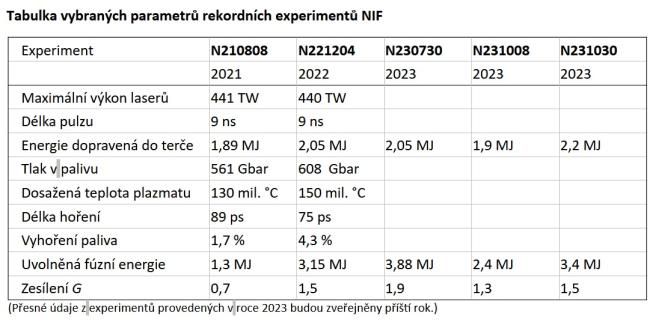
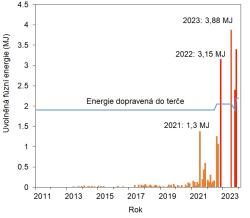 Released fusion energy in NIF experiments. Credit LLNL. |  Four successful NIF experiments. Credit LLNL. |
GO
In parallel with the research on the NIF laser device, intensive research was carried out on the JET (Joint European Torus) tokamak with magnetic fuel retention. Tokamak JET is a European tokamak built in Culham, England, near Oxford. Throughout its operation, JET was the largest fusion reactor in the world. In February of this year, JET ceased operations after 40 years.
As part of the extensive research activities on the JET tokamak, three high fusion power research campaigns have been conducted, the DTE1 campaign in 1997, DTE2 in 2021, and DTE3 in 2023. In 1997, JET achieved a fusion power of 16 MW, in 2021 it was able to release 59 MJ of fusion energy and released it in an experiment in 2023 104522 the most fusion energy of any device in the world 69 MJ.

JET tokamak reactor chamber. EUROfusion credit.
A record-breaking experiment 104522 had the main objective of optimizing the operational scenario at high fusion performance. Thanks to the effective stabilization of the plasma, a record amount of fusion energy was released during the experiment.
A D-shaped diverted toroidal plasma was created in the reactor with a small diameter of 1.8 m at a ring diameter of 6 m and a volume of approximately 90 m3. The plasma was kept in the axis of the reactor chamber by a helical magnetic field of 3.85 T. The fuel consisted of deuterium and tritium ions in a ratio of 2:8 with a density of approximately 9×1019 particles/m3. The unusual ratio of fuel isotopes and the application of deuterium heating beams made it possible to make maximum use of the reaction potential of accelerated deuterium ions with superthermal speed in the process of beam-target fusion reactions. Under certain circumstances, especially in current insufficiently sized reactors, this procedure may be more advantageous than a 1:1 fuel mix maintained at a higher temperature, where nuclear fusion takes place mainly on the basis of thermal splitting of plasma ions.
After creation, the plasma was heated by an electric current of 2.5 MA, beams of accelerated neutral deuterium atoms with an energy of 130 keV and a power of 30 MW, and electromagnetic waves at a deuterium ion cyclotron resonance frequency of 25 MHz with a power of 5 MW. One second after start-up, the reactor reached an operating plasma electron temperature of 10 keV and fusion power exceeded 12 MW. The reactor then maintained fusion power between 14 and 11 MW for 5 seconds. The average reactor gain was 0.36. The neutron flux varied from 4×1018 up to 5×1018 n/s
The reactor structure was protected from the hot plasma by the first wall made of beryllium, the divertor targets on which the plasma continuously hits were tungsten. The fusion reaction consumed 0.2 mg of DT fuel. During the experiment, the reactor continuously released high-power fusion energy, and its thermal output was around 48 MW.
The JET reactor successfully repeated and refined the high fusion power experiments from the previous campaign in 2021. Over the entire JET campaign, it released more than 500 MJ of fusion energy. In doing so, he demonstrated the reliability and maturity of operational scenarios and operational methodologies of tokamaks. The tested operational scenarios will be the main basis for the compilation of operational scenarios and the successful operation of the ITER reactor and the European prototype of the DEMO fusion power plant.

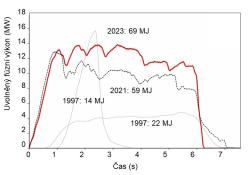 Released fusion power and energy in the JET experiments. EUROfusion credit. | 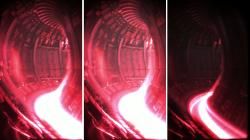 Images of the interior of the JET reactor during experiment 104522. The plasma is transparent, the glow at the bottom of the reactor shows the interaction of the plasma with the divertor targets. EUROfusion credit. |
Summary

The achieved record results mark a significant breakthrough in fusion research and confirm that fusion research on both magnetic and inertial fuel retention is heading in the right direction. Currently, plasma physics research continues with the aim of a deeper understanding of physical processes in hot plasma and the development of fusion device technologies.
Research into nuclear fusion with inertial fuel retention is still in the phase of physical research, but research into nuclear fusion with magnetic fuel retention is already solving technological issues and is ready for transfer to the energy industry. The start of construction of the first fusion power plants is expected around 2040.














